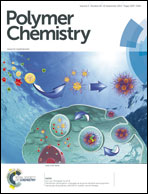Novel metallo-dendrimers containing various Ru core ligands and dendritic thiophene arms for photovoltaic applications
Abstract
Three series of supramolecular mono-(i.e., Ru1G1, Ru1G2 and Ru1G3), bis-(i.e., BTRu2G1, BTRu2G2 and BTRu2G3) and tris-(i.e., TPARu3G1, TPARu3G2 and TPARu3G3) Ru-based dendritic complexes were synthesized. Their photophysical and electrochemical properties were investigated. These metallo-dendritic complexes covered a broad absorption range of 250–750 nm with optical bandgaps of 1.51–1.86 eV. The energy levels of the metallo-dendrimers can be effectively adjusted not only by different generations of dendritic thiophene arms but also by their π-conjugated core ligands bearing various electron donor (i.e., triphenylamine) and acceptor (i.e., benzothiadiazole) moieties. Due to the donor–acceptor effect, the bis-Ru-based dendrimers containing a benzothiadiazole electron-acceptor core ligand showed the highest power conversion efficiency (PCE) among these three series of metallo-dendrimers. The tris-Ru-based architecture with a triphenylamine electron-donor core ligand revealed moderate photovoltaic performance. Among the different generations (G1–G3) of dendrimers, the third generation (G3) possessed the highest PCE values in each series of Ru-based dendrimers. Hence, the third generation bis-‘Ru’-based dendrimer BTRu2G3 blended with PC70BM (1 : 3 w/w) showed the highest PCE value of 0.77% (without the aid of additives or annealing), which is the highest efficiency among all bulk hetero-junction (BHJ) solar cells containing metallo-dendrimers reported to date.


 Please wait while we load your content...
Please wait while we load your content...